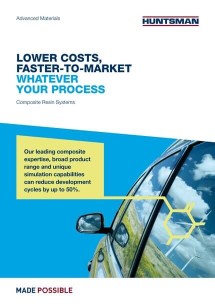Sheet Molding Compound
Sheet Molding Compounds (SMCs) are a type of prepreg made with short fibers (15 to 50 mm). They present a lighter alternative to aluminum, and offer a good compromise between performance and cost. SMCs are ideal for interior parts such as C-pillar reinforcements and partition walls. Huntsman provides components for formulating SMC epoxy matrices, as well as semi-formulated epoxy systems.


